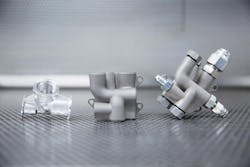Additive manufacturing increases yacht racing performance
WEST DUNDEE, IL – Land Rover Ben Ainsile Racing (BAR) is no stranger to cutting-edge technologies. The British yacht racing team uses additive manufacturing (3D printing) to gain competitive advantages. The technology has been incorporated into daily use at Land Rover BAR by the team's Technical Innovation Group (TIG). Renishaw, a manufacturer of metal additive manufacturing machines, is a TIG partner. The partnership has allowed the team's engineers to design and test precision custom parts quickly and cost-effectively in the shop, and gives their yacht an edge on the water (FIGURE 1).
"We use 3D printing at three different levels," says George Sykes of PA Consulting, who is the TIG project manager. "The simplest level is as a prototyping and visualization tool. We manufacture a large number of custom parts and 3D printing allows us to make full-size prototypes in-house before we commit to a design."
"The prototyping process is really useful when we are trying to develop a new idea," says Andy Claughton, Land Rover BAR's CTO. "It allows us to get our hands on it, put it in place on the boat, or link it up with other parts of the system, and see potential issues and refine the design before we commit to the production of the final piece."
The team has its own fully equipped traditional machine shop, as well as an extensive additive shop facility. Between them, these facilities can make almost anything—if the final part can be 3D-printed, then they use that option because typically the cost can be significantly reduced.
For example, the end cap for the boat's bowsprit—a complex shape designed to reduce aerodynamic drag—is ideal for 3D printing because there was no load involved and a single item was required. In the past, this would have been built in carbon fiber to the finish specs and standards of a piece of custom furniture, and would have been very expensive because of the time and skill of those involved. Once the design has been developed, it can be produced by laser additive manufacturing in a handful of hours and at a much lower cost.
The Land Rover BAR team manufactures custom components from thin layers of fine metallic powder. One of the earliest components was a custom sheave case for the pulley in the daggerboard lift line that needed good resistance to wear, so metal was the ideal choice. To keep weight down, the final design was hollow—so additive manufacturing eliminates the difficulty present in other methods to be able to produce this part.
They also looked at their hydraulics system. The shapes created conventionally are limited, so the design and the flow are as well, as there is a loss of power when hydraulic fluid goes around hard corners. This might be the only way to manufacture the part with traditional techniques—but additive manufacturing can build it with smooth, rounded corners to significantly improve efficiency in the fluid transfers involved (FIGURE 2).
In addition, parts can be built more lightly as material is added specifically where it is needed. In the past, the geometry of manufacture on a lathe or other cutting tool meant that some material couldn't be removed, so excess weight was carried around. Renishaw says that weight in a new AM manifold design was reduced by 60%, with an increase in performance efficiency of better than 20%.
"Our involvement with Land Rover BAR is also helping to raise the bar in additive manufacturing," says David Ewing, product marketing engineer at Renishaw's Additive Manufacturing Products Division. "It's a complex manufacturing option and there are considerations both in component design and process expertise. The best applications are ones which use the minimum amount of material to achieve the design requirements, offer a functional benefit in service, and have been designed with the manufacturing method in mind. Our work on hydraulic parts for the team is a perfect example."


